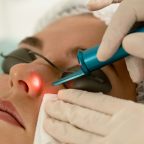
Hormone Replacement Therapy: All You Need to Know
Hormone replacement therapy is performed to balance the estrogen and progesterone levels in women, primarily around the time of menopause. Hormone therapy is used to reduce the risk of osteoporosis and to relieve symptoms of menopause like sweating and hot flashes.
Progesterone and estrogen are mainly used in HT; however, testosterone is also used in some therapies. Hormone therapies are also used in males that undergo a sex-change operation. If you feel a need to talk with a medical expert visit https://www.hgha.com where you can surely have a free and qualified consultation
Menopause
Estrogen and Progesterone are vital hormones in a woman's reproductive system. Progesterone prepares the womb for egg implantation, whereas, estrogen facilitates the release of eggs. As a woman grows older, estrogen production is reduced, and the release of eggs is diminished. A woman starts experiencing perimenopause in her 40s till menopause that occurs during the late 40s or early 50s.
Menopause increases the risk of osteoporosis and can also cause menopause-related problems like hot flashes. Menopause can also be triggered by hysterectomy, cancer treatment, or excessive smoking. Some common effects of menopause are:
- vaginal dryness
- osteoporosis
- hot flashes and night sweats
- irregular periods
Other common problems like thinning or loss of hair, lower fertility, and smaller breasts can also occur.
Advantages of Hormone Replacement Therapy
All the effects mentioned above can make a woman uncomfortable, unhealthy, and sick. Hormone therapy can provide some relief as it helps in relieving menopause-related symptoms. Some advantages of hormone replacement therapy are:
- It is effective in reducing and relieving symptoms of menopause and perimenopause.
- It can reduce the risk of hot flashes and sweating.
- It can reduce the severity of osteoporosis.
- It can also help keep the skin young for an elongated period.
Different Types of Hormone Replacement Therapy
Hormone therapies are given in various types by using multiple delivery and combination of hormones. Five common types of HRT are discussed below.
Estrogen-only HRT: Women that have undergone a hysterectomy in which their ovaries or womb have been removed, do not need progesterone.
Cyclical / Sequential HRT: Sequential HRT is ideal for women that have not reached menopause but are experiencing the symptoms of premenopause. In this form of therapy, a dose of estrogen plus progestogen is given regularly, which can be either daily or monthly, depending upon the condition of the patient.
Continuous HRT: Continuous HRT is provided to women during postmenopause, and it includes the intake of a continuous combination of estrogen and progestogen.
Long-cycle HRT: Long-cycle HRT causes withdrawal bleeds every three months, but its security and effectiveness are still questionable.
Local estrogen: Local estrogen treatment consists of vaginal tablets, creams, or rings, and is used to treat urogenital problems, including irritations and dry vagina.
How is Hormone Therapy Given?
HRT can be given in various ways ranging from creams to tablets. Injections are the most effective HRT method in which your therapist prescribed you a proper dosage and frequency of using. HRT can be given by other means well, as mentioned below.
- Vaginal rings
- Tablets
- Creams or gels
- Skin patches
- Injections
When to Avoid HRT?
HRT is not suitable for women with certain medical conditions mentioned below.
- Hypertension (too high)
- Severe migraines
- Cardiovascular problems like stroke
- Breast, ovarian, or endometrial cancer
- Thrombosis or blood clots
- Pregnant (or expecting to get pregnant) women
HRT and Cancer: A myth or reality?
Hormone therapy was used widely for reducing menopause-related symptoms and providing relief from conditions like osteoporosis and hot flashes. However, fingers were pointed at hormone therapy, as some studies suggested that HRT is responsible for causing ovarian, endometrial, and breast cancer. Various more studies were performed, and the results that were achieved were mixed. Since HRT consists of different hormonal combinations, some complications can occur.
Studies suggest that one out of every 1,000 women that undergo hormone replacement therapy, only one woman, is exposed to the risk of breast cancer. Therefore, although there are some risks, the benefits of HRT outweigh the risks.
Other Benefits
- Apart from menopause-related advantages, hormone therapy also offers other benefits, including:
- Reduced risk of cardiovascular problems like heart failure and heart attack
- Improved muscle function
- Reduced chances of mortality in postmenopausal women
- Prevention of skin aging in some women
- Prevention is Better than Cure
You can avoid the use of HRT if you make certain changes in your lifestyle that can smoothen your menopause process. These changes are:
- Reduce the consumption of alcohol, tobacco, and caffeine
- Exercise regularly
- Don't wear tight clothes
- Sleep in a cool, well-ventilated room
Conclusion: Should You Undergo Hormone Replacement Therapy?
Hormone replacement therapy is used to eliminate the symptoms of menopause like hot flashes and osteoporosis. Although not necessary, HRT is crucial in some severe cases when the symptoms are serious. However, HRT can be avoided by making some changes in your lifestyle. HRT is also rumored to cause ovarian or breast cancer; however, more research is needed on this topic.



















